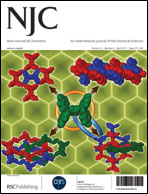Two classes of blue emitters bearing electron-rich or electron-deficient units were developed for organic light-emitting diodes. Such shape persistent three-dimensional (3D) structures provided six molecules emitting pure and stable blue light. The photophysical, electrochemical, and thermal properties as well as the thin film morphologies of these blue emitters were investigated in detail. These results indicated that the side groups did not change the photophysical properties, but significantly affected the electrochemical properties to improve the charge injection and the aggregation behaviours of the molecules. The electroluminescence performance was greatly improved without using 1,3,5-tris(N-phenylbenzimidazol-2-yl)benzene (TPBI) as an electron injection layer after the introduction of Taz and Oxd as the side groups. In comparison with sFOMe, 9,9′-spirobifluorene-containing compounds (sFTaz, and sFOxd) exhibited better electroluminescence due to the improvement of the electron injection ability after the introduction of electron-deficient groups. These investigations provide us with an important way to improve the OLED efficiency through the modification of the chemical structure.

You have access to this article
 Please wait while we load your content...
Something went wrong. Try again?
Please wait while we load your content...
Something went wrong. Try again?


 Please wait while we load your content...
Please wait while we load your content...